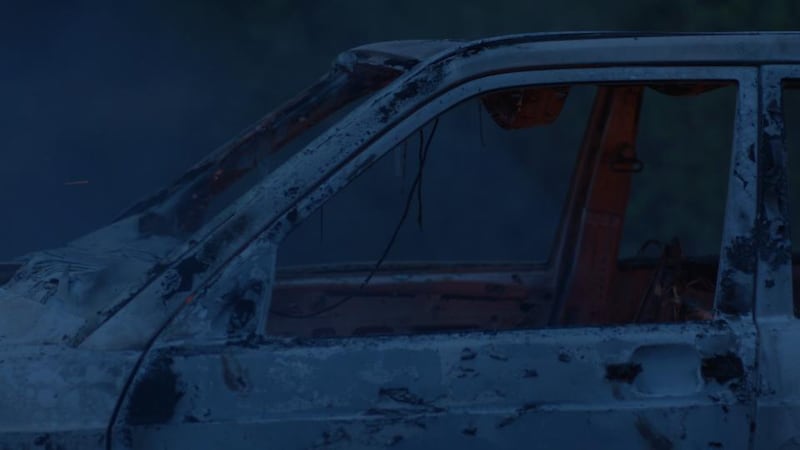Last year's impressive, compact retrospective of the work of Willie Doherty as part of Derry's City of Culture programme included a new 15-minute video film work that had debuted at Art Basel last June. That film, Remains , is the centrepiece of Doherty's current exhibition at the Kerlin Gallery, where it is beautifully installed in a custom-made space.
If you are familiar with the artist’s work, it probably won’t surprise you to learn that it is a dark, brooding, troubling film. What might surprise you is that at least one visitor found it just too disturbing and had to leave halfway through.
Despite the fraught nature of his subject matter, Doherty doesn't do cinematic violence in the Quentin Tarantino sense of the term. As the title of his retrospective – Unseen – implied, he does not deal with the explicit, but with hidden histories, tensions and antagonisms inscribed in the familiar, everyday surface of things.

Derry upbringing
Doherty was born in Derry in 1959, and he is, to an extraordinary degree, Derry's artist. The city and its hinterland have been at the centre of his work from the mid-1980s onwards.
Doherty was 12 when he chanced to witness Bloody Sunday from a bedroom window of his home. He was struck by the disjuncture between what he saw and the subsequent news reports. He also notes that he cannot be precisely sure what he saw, memory being what it is.
All of this goes some way to explaining why he has devoted his creative energies to disentangling the complexities of his immediate geographic and political terrain.
But he also, crucially, has consistently explored the way that all territories are shaped and marked by political and ideological factors.
It is fair to say that his big international reputation rests at least as much on his analytical ability to see the universal in the particular as on the widespread interest in Northern Ireland during the Troubles. At the same time, it is the immediacy of his connection to his material that lends his work gritty authenticity. When he moved, experimentally, beyond the artistic boundaries of Northern Ireland, what he produced was polished and involving, but comparatively lacking and disconnected.
As with several of Doherty's film installations, Remains is a fictional work with its feet very much in the real world. A doleful narrator (Adrian Dunbar) threads a sparse, fragmentary story through a succession of images: slow tracking shots through a bleak, anomalous urban space, interspersed with studies of a car that is engulfed by flames, flaring into a fireball that gradually dies down but continues to burn.
It is interesting that several published descriptions of the film suggest that it ranges more widely through the city than it does. Doherty is forensic in detailing small tracts of walled-off, fenced-off, rough, functional spaces. He mentions the yards behind the Creggan shops. The camera moves along, obsessively examining the ground strewn with bits and pieces, random wind-blown litter, rubbing our noses in the dirt, which, as we learn, is what happened to the narrator when he was summoned by paramilitaries, for ritualistic punishment for an unspecified misdemeanour.
We hear of three such punishments. The description is spare and ambiguous but the first is a beating, perhaps as early as the 1970s, the second a knee-capping in the 1980s and, pointedly, the final one a kneecapping just a couple of years ago, post-peace process. Furthermore the narrator is the obedient recipient of the first two, while, for the last, he is an Abraham who passively sacrifices his own son to the omniscient, unseen judges.
It’s a simple but allegorically rich piece that throws out many ideas. There’s the circularity of history, and behaviour patterns passed from generation to generation – “Like father, like son, isn’t that what they say?” Dunbar mournfully intones at one point. Most worryingly, perhaps, is the implication that Doherty might regard the gains of the peace process as being no more than skin deep. The scars of the traumatic past are deeply scored into the fabric of place, he suggests. “Sour milk,” the sacrificial victim reports, inhaling as his face is pressed into the ground.
Then there’s the burning car, indicating the obliteration of evidence but also, to continue the biblical association, symbolic of perpetuity. Mulling on his own abject surrender in the wider social and political context, the narrator diagnoses “a failure to reimagine the future”. One can’t help but feel that Doherty is expressing his own doubts about Northern Ireland at this moment, and the continuing danger of living in the past.
Remains,
video
installation by Willie Doherty. Kerlin Gallery, Anne's Lane, South Anne Street, Dublin
until March 15,
kerlin.ie









